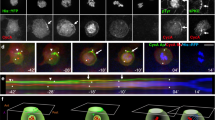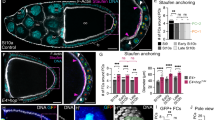Abstract
During metazoan development, cell-fate diversity is brought about, in part, by asymmetric cell divisions1. In Drosophila, bristle mechanosensory organs are composed of four different cells that originate from a single precursor cell, pI, after two rounds of asymmetric division2. At each division, distinct fates are conferred on sister cells by the asymmetric segregation of Numb, a negative regulator of Notch signalling3,4,5,6. Here we show that the orientation of the mitotic spindles and the localization of the Numb crescent follow a stereotyped pattern. Mitosis of pI is orientated parallel to the anteroposterior axis of the fly. We show that signalling mediated by the Frizzled receptor polarizes pI along this axis, thereby specifying the orientation of the mitotic spindle and positioning the Numb crescent. The mitoses of the two cells produced by mitosis of pI are orientated parallel and orthogonal, respectively, to the division axis of pI. This difference in cell-division orientation is largely independent of the identity of the secondary precursor cells, and is regulated by Frizzled-independent mechanisms.
This is a preview of subscription content, access via your institution
Access options
Subscribe to this journal
Receive 51 print issues and online access
$199.00 per year
only $3.90 per issue
Buy this article
- Purchase on Springer Link
- Instant access to full article PDF
Prices may be subject to local taxes which are calculated during checkout



Similar content being viewed by others
References
Horvitz, H. & Herskowitz, I. Mechanisms of asymmetric cell division: two Bs or not two Bs, that is the question. Cell 68, 237–255 (1992).
Hartenstein, V. & Posakony, J. W. Development of adult sensilla on the wing and notum of Drosophila melanogaster. Development 107, 398–405 (1989).
Rhyu, M. S., Jan, L. Y. & Jan, Y. N. Asymmetric distribution of Numb protein during division of the sensory organ precursor cell confers distinct fates to daughter cells. Cell 76, 477–491 (1994).
Knoblich, J. A., Jan, L. Y. & Jan, Y. N. Asymmetric segregation of Numb and Prospero during cell division. Nature 377, 624–627 (1995).
Frise, E., Knoblich, J. A., Younger-Shepherd, S., Jan, L. Y. & Jan, Y. N. The Drosophila Numb protein inhibits signaling of the Notch receptor during cell-cell interaction in sensory organ lineage. Proc. Natl Acad. Sci. USA 93, 11925–11932 (1996).
Guo, M., Jan, L. Y. & Jan, Y. N. Control of daughter cell fates during asymmetric division: interaction of Numb and Notch. Neuron 17, 27–41 (1996).
Gho, M., Lecourtois, M., Géraud, G., Posakony, J. W. & Schweisguth, F. Subcellular localization of Suppressor of Hairless in Drosophila sense organ cells during Notch signalling. Development 122, 1673–1682 (1996).
Wang, S., Younger-Shepherd, S., Jan, L. Y. & Jan, Y. N. Only a subset of binary cell fate decisions mediated by Numb/Notch signaling in Drosophila sensory organ lineage requires Suppressor of Hairless. Development 124, 4435–4446 (1997).
Lawrence, P. A. Gradients in the insect segment: the orientation of hairs in the milkweed bug Oncopeltus fasciatus. J. Exp. Biol. 44, 607–620 (1996).
Bate, C. M. in Handbook of Sensory Physiology (ed. Jakobson, M.) 1–52 (Springer, Berlin, 1978).
Lieber, T., Kidd, S., Alcano, E., Corbin, V. & Young, M. W. Antineurogenic phenotypes induced by truncated Notch proteins indicate a role in signal transduction and may point to a novel function for Notch in nuclei. Genes Dev. 7, 1949–1965 (1993).
Adler, P. N. The genetic control of tissue polarity in Drosophila. Bioessays 14, 735–741 (1992).
Park, W.-J., Lin, J. & Adler, P. N. The frizzled gene of Drosophila encodes a membrane protein with an odd number of transmembrane domains. Mech. Dev. 45, 127–137 (1994).
Krasnow, R. E., Wong, L. L. & Adler, P. N. dishevelled is a component of the frizzled signaling pathway in Drosophila. Development 121, 4095–4102 (1996).
Jones, K. H., Lin, J. & Adler, P. N. Molecular analysis of EMS-induced frizzled mutations in Drosophila melanogaster. Genetics 142, 205–215 (1996).
Gonczy, P. & Hyman, A. Cortical domains and the mechanisms of asymmetric cell division. Trends Cell Biol. 6, 382–387 (1996).
Kraut, R., Chia, W., Jan, L. Y., Jan, Y. N. & Knoblich, J. A. Role of inscuteable in orientating asymmetric cell divisions in Drosophila. Nature 383, 50–55 (1996).
Thorpe, C. J., Schlesinger, A., Clayton Carter, J. & Bowerman, B. Wnt signaling polarizes an early C.elegans blastomere to distinguish endoderm from mesoderm. Cell 90, 695–705 (1997).
Rocheleau, C.et al. Wnt signaling and an APC-related gene specify endoderm in early C. elegans embryos. Cell 90, 707–716 (1997).
Sawa, H., Lobel, L. & Horvitz, H. R. The Caenorhabditis elegans lin-17, which is required for certain asymmetric cell division, encodes a putative seven-transmembrane protein similar to the Drosophila Frizzled protein. Genes Dev. 10, 2189–2197 (1996).
Usui, K. & Kimura, K. Sequential emergence of the evenly spaced microchaetes on the notum of Drosophila. Arch. Dev. Biol. 203, 151–158 (1993).
Emery, J. F. & Bier, E. Specificity of CNS and PNS regulatory subelements comprising pan-neural enhancers of the deadpan and scratch genes is achieved by repression. Development 121, 3549–3560 (1995).
Acknowledgements
We thank P. Adler, E. Bier, D.Coen, F. Chanut, C. Doe, Y.-N. Jan, T. Lieber and the Developmental Studies Hybridoma Bank for flies and antibodies; F. Rosa and M. Wassef for critical reading of the manuscript; and the Imaging facility of the Institut Jacques Monod for use of confocal microscopes. This work was supported by grants from the CNRS, the MENESR, the Fondation pour la Recherche Medicale, the Association pour la Recherche contre le Cancer and the Ligue Nationale contre le Cancer — Comité de Paris.
Author information
Authors and Affiliations
Corresponding author
Rights and permissions
About this article
Cite this article
Gho, M., Schweisguth, F. Frizzled signalling controls orientation of asymmetric sense organ precursor cell divisions in Drosophila. Nature 393, 178–181 (1998). https://doi.org/10.1038/30265
Received:
Accepted:
Issue Date:
DOI: https://doi.org/10.1038/30265
This article is cited by
-
Cortical Cyclin A controls spindle orientation during asymmetric cell divisions in Drosophila
Nature Communications (2022)
-
Intracellular trafficking of planar cell polarity proteins
Frontiers in Biology (2018)
-
A role for core planar polarity proteins in cell contact-mediated orientation of planar cell division across the mammalian embryonic skin
Scientific Reports (2017)
-
The PCP pathway regulates Baz planar distribution in epithelial cells
Scientific Reports (2016)
-
Endocytosis by Numb breaks Notch symmetry at cytokinesis
Nature Cell Biology (2012)
Comments
By submitting a comment you agree to abide by our Terms and Community Guidelines. If you find something abusive or that does not comply with our terms or guidelines please flag it as inappropriate.



